10 Ingredients To Upgrade Your Bruschetta
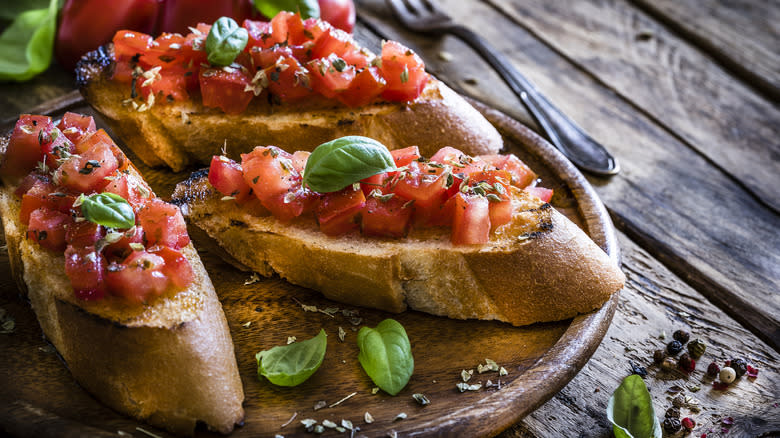
Homemade bruschetta is one of the easiest and most delicious appetizers out there. The classic Italian combination of chopped tomatoes, basil, and vinegar on toast is such a crowd pleaser. Plus, it can easily be adapted to feed any number of people from six to 60. You can prep all your ingredients ahead of time, and assemble just before serving. Or even easier, let your guests make their own.
That being said, classic bruschetta can be a little predictable. All too often, lackluster ingredients transform what should be a delicious appetizer into a flavorless mess. Maybe you've only got subpar tomatoes, perhaps your bread has gone stale, or your basil has started to turn. There's no need to panic! Thankfully, bruschetta is a forgivable format that's endlessly adaptable. Whether you're looking to jazz up your usual recipe or make the best of a sad tomato, these ingredients are sure to transform your average bruschetta into something people will remember.
Read more: The 20 Best Olive Oils For Cooking
Extra Virgin Olive Oil
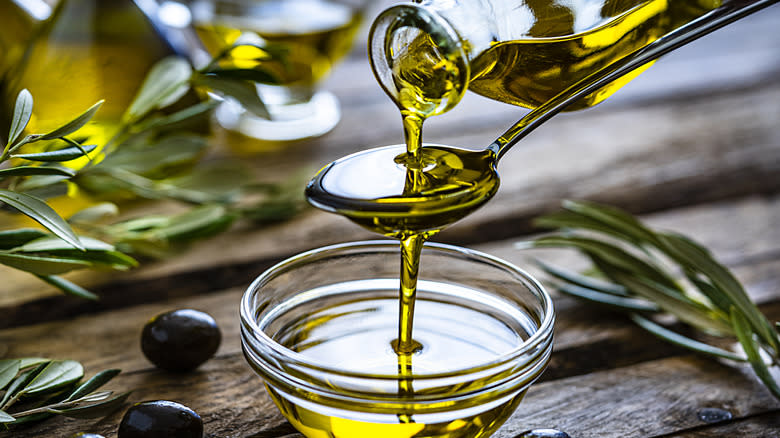
Since bruschetta has so few ingredients, you can really taste the quality of each one. The olive oil you use will arguably have the biggest impact on its overall flavor. This isn't the time for light cooking oil, you absolutely need to use the good stuff. Real, cold-pressed extra virgin olive oil is full of organic compounds called polyphenols. These are what create that classic olive oil taste with its signature slightly peppery notes. Since bruschetta is uncooked, the flavor of the olive oil you use will really shine through.
When buying extra virgin olive oil, read the label carefully to make sure you know what you're paying for. Avoid words like "light" and "pure", which mean the oil has been refined and many of those delicious polyphenols have been removed. If you can, try to find a bottle with the olive harvest date. The fresher the oil, the more polyphenols and flavor! If you don't have access to extra virgin olive oil, at least choose one that comes in a dark bottle. Clear packaging causes oil to deteriorate faster and those flavor compounds to oxidize.
Roasted Garlic
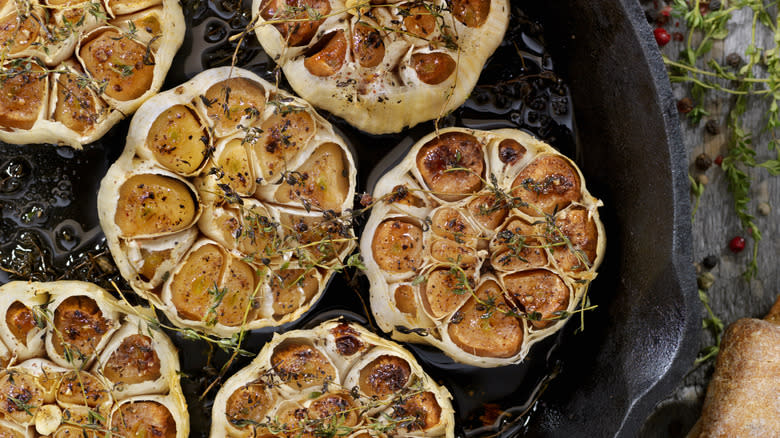
More often than not, bruschetta recipes include raw garlic. Sometimes you'll be instructed to mince a few cloves into your tomato mixture. Other times you'll be told to rub each slice of bread with a clove of raw garlic before spooning over the topping. While garlic is one of the most universally loved flavors, it can have an off-putting pungency in its raw form. Plus, it can be difficult for some people to digest.
For a deeper, sweeter garlic flavor, try using roasted garlic instead. In fact, some say roasted garlic is superior to raw. Roasting whole heads of garlic in a hot oven really mellows out the flavor. Plus, the sugars caramelize into a wonderfully sweet, rich flavor. Once fully cooked, roasted garlic is almost as soft as room temperature butter. You can easily spread it across each slice of bread with a knife — no need to get raw garlic under your fingernails. Next time you make bruschetta, try our recipe for oven roasted garlic. It only takes a few minutes of prep time, and the payoff is well worth it.
Fresh Herbs
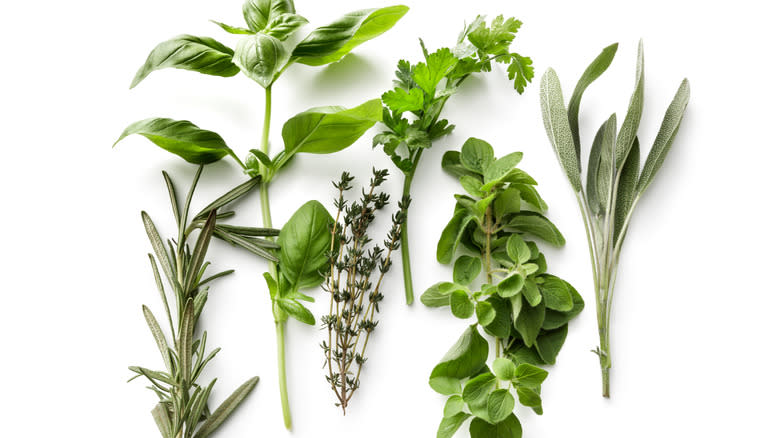
With an uncooked dish like bruschetta, fresh herbs are always the better choice. They provide a pop of color and crisp flavor that their dried counterparts just can't live up to. Dried herbs have a concentrated flavor that works well for soups or stews, but can be overwhelming in raw applications such as bruschetta. They can overcome the more subtle flavors of your olive oil and tomatoes, their gritty texture can create an unpleasant mouthfeel, plus their desaturated color doesn't do much for your bruschetta's visual appeal.
On the other hand, fresh herbs such as basil, parsley, or thyme enliven your bruschetta with their clean flavor and bright green color. Be as generous as your heart desires, it's almost impossible to add too many fresh herbs. If you can, use ones you've grown yourself since you can be sure they're at their freshest. If that doesn't work for you, store-bought fresh herbs are also great as long as you use only the most perfect, unblemished leaves. In a pinch, you can also use dried herbs if that's all that's available to you. Just be lenient and make sure they're not expired.
Peppers
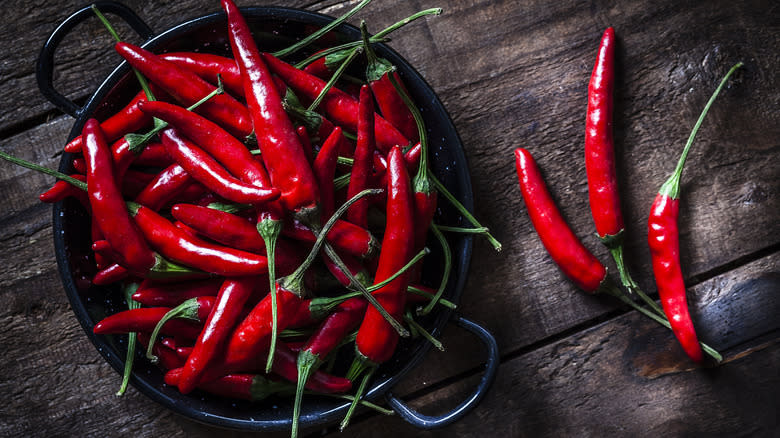
Whether you like your food spicy or not, a bit of minced pepper stirred into the tomato mixture will bring a bit of sweetness and a breath of capsaicin. If spicy food isn't your thing, stick to bell peppers or the sweet mini peppers you sometimes see in the produce aisle. The red, orange, and yellow bell ones have a fruity flavor, whereas green and purple bell peppers tend to be more bitter and vegetal.
On the other hand, if you want to bring the heat, you have a whole world of chilis to choose from. There are thousands of kinds all over the world, but our visual guide to different types of chiles can get you started. You can control the heat to a degree by removing some or all of the seeds and the white inner membranes, just be sure to wash your hands well afterward. Before adding your chosen peppers, taste a slice on its own to gauge its spiciness. It can vary from one pepper to the next, even if they're from the same plant.
Capers
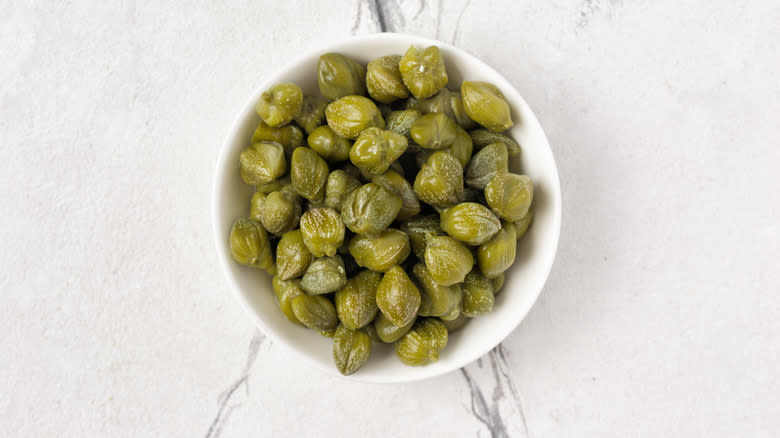
If you've ever had a fully loaded bagel with lox, then you know how good capers and tomatoes can be together. These briney little buds are bursting with umami flavor that's especially tasty next to something fatty, like smoked salmon or extra virgin olive oil. Capers are the unopened flower buds from the Capparis spinosa bush preserved in either salt or brine. They come divided by size, with tiny nonpareils at one end of the spectrum and chubby grass on the other.
Brined capers can turn soggy as they sit in the fridge, so use up the jar within a reasonable amount of time once you've opened it. Salted capers retain a firm texture for much longer, but you'll need to rinse off the salt before you use them. Whichever you choose, you should invest in quality capers for maximum flavor. But caper buds aren't the only part of the plant that's edible. You can also bring the caper flavor with preserved caperberries, which are larger and meatier, or with caper leaves, which are milder and visually striking. If you'd like to play up textural contrasts in your bruschetta, you can try deep frying caper buds in olive oil. They bloom upon contact with the hot oil and become nice and crunchy.
Cheese
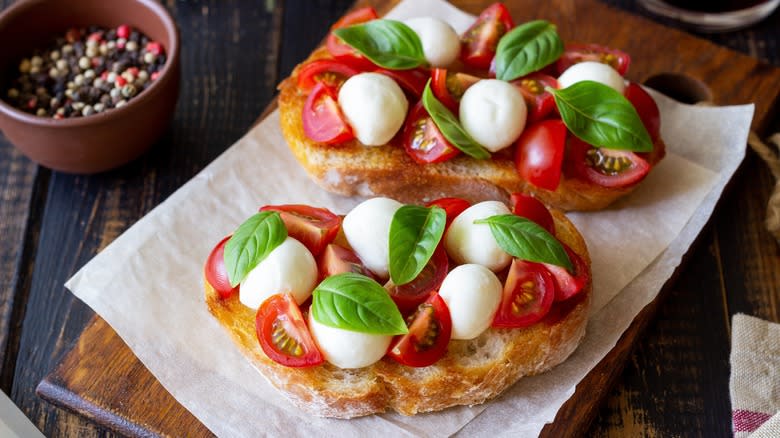
Cheese improves most dishes in the Western canon, and bruschetta is no different. It should come as no surprise that mozzarella is the perennial favorite here. Tomatoes and mozzarella are one of the most classic pairings in the book. The main thing to keep in mind is that you and whomever you're feeding will be eating the cheese raw. This is absolutely not the time for anything pre-shredded. Pre-shredded packaged cheese brings anti-caking agents along with it that will ruin the texture of your bruschetta. Instead, opt for the freshest mozzarella you can find and afford, then cut or shred it to size. If you're lucky, you may come across tiny balls of mozzarella labeled "perlini" that are just the right size for mixing with your chopped tomatoes. The slightly larger ciliegne also works great.
Of course, many kinds of cheese make for delicious bruschetta. Other fresh cheeses like goat's cheese, feta, or ricotta are quite common. In our all-star tomato bruschetta recipe, we even whip the ricotta until it's light and fluffy to create a pillowy base for the tomato mixture. That being said, don't shy away from the stronger cheeses. You could try for example blue cheese crumbles or thick shards of parmigiano reggiano.
Strawberries

When in season, strawberries make a great springtime bruschetta topping. They add a refreshing, sweet flavor that sings when paired with fresh herbs like mint or basil. You can add strawberries to your bruschetta mix, or replace the tomatoes entirely like we did for our strawberry bruschetta recipe. If you're keeping both, try to cut the strawberries and tomatoes to around the same size. This way you can be sure each bite has a nice blend of both flavors.
If you're going with strawberries, be mindful of the vinegar you choose. You don't want to overpower them with anything too acidic. Frankly, there's no need to look further than balsamic vinegar. Strawberries and balsamic are a first-rate pairing, and the better your vinegar the more delicious it'll be. If strawberries aren't in season and you'd still like to add fruit to your bruschetta, there are plenty of other options. In the summer, try figs or stone fruit such as peaches, plums, or nectarines. In the winter, reach for a pomegranate.
Bacon
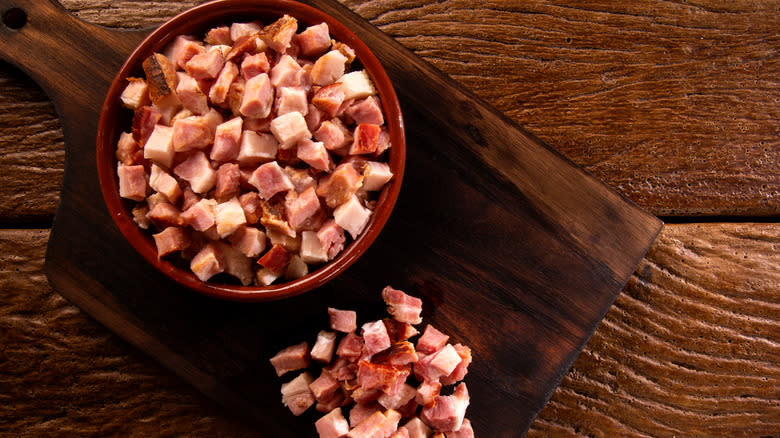
The bacon craze may have reached its height over a decade ago, but it turns out cured pork belly is still as delicious as ever. Ever heard of a BLT? Of course you have. The combination is eternal. Omit the lettuce, chop the bacon, and remove the top half of the sandwich and you've got a bacon bruschetta. What makes tomatoes and bacon so tasty together are the contrasts. Juicy, sweet, slightly acidic tomatoes perfectly balance out the crispy, salty, umami-laden bacon. Since it's already so fatty, you won't need any oil in your bruschetta mixture. Cook the bacon until it reaches your desired crispiness, drain it on paper towels, then coarsely chop and set aside. Don't mix it in with the tomatoes until just before serving time, or it'll lose its crunch. Alternatively, you could simply crumble the bacon on top of each bruschetta piece.
Feel free to experiment with any kind of cured pork product, there's no need to feel limited to American-style bacon. Crisped prosciutto, jamón serrano, or even chorizo would provide the same crunchy, salty, umami kick. Just be sure to remove any casing on the meat.
Olives
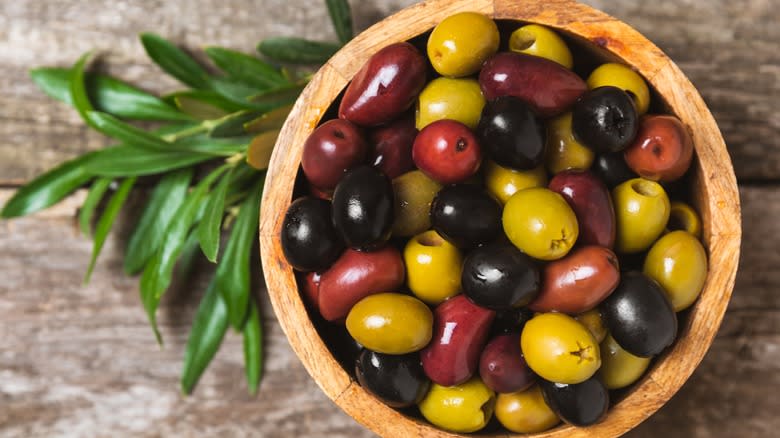
Just like bacon, olives provide an umami, salty, fatty foil to your tomatoes. Green, black, red, cured in oil or brine, it's hard to go wrong. It all comes down to personal preference since any kind of olive can make a great addition to bruschetta. Does it matter if you go for pre-pitted or whole olives? Yes. Pitted olives tend to be softer and sweeter, whereas olives with their pits are firmer and more flavorful. If you're short on time or starved for options, go for pitted olives. They're convenient and quickly sliceable. To make a really speedy bruschetta, choose olives marinated in olive oil, herbs, and other seasonings. Coarsely chop the olives and add them, along with their flavorings, directly to your chopped tomatoes.
But if you can spare the labor, it's well worth buying whole olives and pitting them yourself. Your extra effort will be rewarded with extra olive flavor. If like most people you don't own an olive pitter, you can crush them on a cutting board with a heavy knife until they split open, then pry out the pits with your fingers. Some varieties of olives will be easier to pit than others, so choose wisely.
Onion
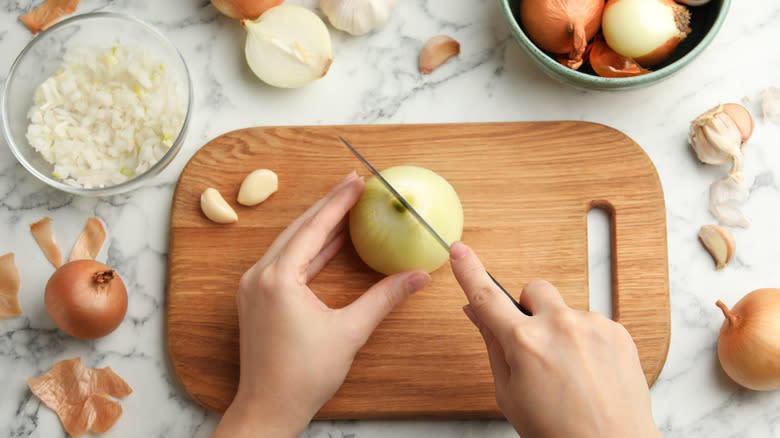
Minced onion can add a nice crunch and tangy flavor that brightens your overall dish. You can choose pretty much any member of the allium family, including red, white, or yellow onions, scallions, shallots, or spring onions. You can add them raw or cooked, just be sure to mince them finely since larger chunks will fall off your bruschetta.
If you want to use raw onion but find the taste a bit too potent, you can subdue their flavor by soaking the sliced onion in ice cold water. This brisk bath subdues the enzymes responsible for that strong oniony taste that can sometimes overpower every other flavor in your dish. Another option is to pop the onion in the freezer for a few minutes or at least rinse it in cold water, which will help take off that extra oniony edge. To avoid this issue entirely, try to choose the smallest, freshest onions available to you. The larger the onion and the longer it's been out of the ground, the stronger its flavor.
Read the original article on Tasting Table.

